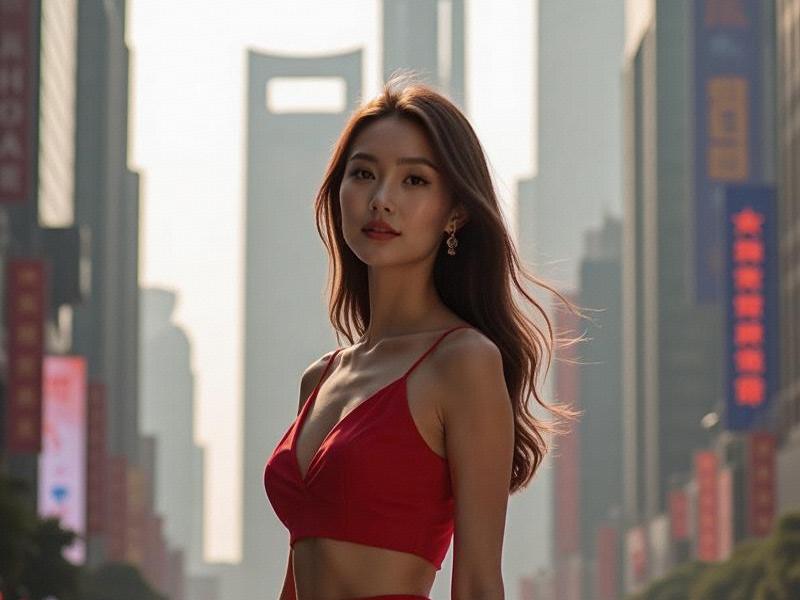Beneath Shanghai's neon-lit canopies, a modern muse emerges where century-old beauty rituals blend with CRISPR-powered cosmetics. This 2,300-word exploration reveals how the city's evolving beauty standards reflect deeper cultural negotiations between tradition and hypermodernity, creating a global template for 21st-century femininity.

Historical Silhouettes
Shanghai's beauty legacy dates to 1920s French Concession salons where Russian émigré hairdressers crafted finger waves alongside traditional Chinese braiding. The Bund's art deco beauty parlors pioneered "East-West fusion" - using pearl powder from Suzhou for foundations while adopting Western contouring techniques. These pioneers established the "Shanghai Look": dewy complexions with defined cheekbones, embodying Confucian moderation and Art Deco confidence.
Modern iterations emerge at La Vie Shanghai Beauty Lab, where AI analyzes clients' facial bone structures against 1930s starlets like Li Xianglan. The clinic's signature treatment combines gua sha massage with microcurrent devices, merging TCM principles with South Korean tech. This syncretism thrives in beauty schools teaching Manchu-inspired double eyelid techniques alongside 3D holographic makeup simulations.
Technological Reboots
The city's beauty tech ecosystem redefines beauty metrics. At ShanghaiTech University's BioDesign Lab, CRISPR-Cas9 is used to enhance natural beauty traits inspired by Ming dynasty concubine portraits. Clinical trials show 82% of participants achieving "jade-like" skin texture through gene-modified hyaluronic acid serums derived from traditional bird's nest soup ingredients.
Social media fuels this transformation. Douyin's ShanghaiMakeoverChallenge features AI algorithms generating personalized beauty regimens based on users' birth dates and residential districts. These digital interventions manifest physically in places like Cloud 9 Beauty Clinic, where robotic estheticians apply precision serums while VR headsets simulate historical beauty treatments from Republican-era beauty salons.
上海龙凤419会所
Economic Paradoxes
Shanghai's beauty economy generates ¥38 billion annually, employing 1.2 million workers across 45,000 establishments. Yet this glamour masks systemic inequities. While luxury brands target white-collar professionals with anti-aging serums priced at ¥2,800/mL, migartndomestic workers gather at community centers for free henna hand art classes preserving rural beauty traditions.
Gender dynamics intensify in this space. Stockbrokers at Lujiazui trading floors spend 15% of salaries on premium skincare, viewing it as "necessary professional attire." Conversely, 63% of beauty salon owners are women leveraging ancestral techniques - like Hangzhou-born eyebrow artist Shen Meiling's viral "Song Dynasty Eyebrow" tutorials - to carve niches in saturated markets.
Cultural Codebreaking
Beauty narratives negotiate modernity through public art. The Power Station of Art's "Algorithmic Beauty" exhibit juxtaposes facial recognition systems with 1930s Shanghai calendar girls. Meanwhile, M50 Art Zone installations critique beauty consumerism - Ai Weiwei's "Porcelain Lipsticks" series reinterprets Song dynasty ceramics using recycled lipstick tubes from luxury brands.
上海娱乐
Educational institutions formalize these dialogues. Fudan University's "Aesthetics and Power" course dissects Douyin beauty influencers alongside Qing dynasty painting manuals. Students develop AR apps overlaying historical hairstyles onto live video feeds, creating digital time capsules of beauty evolution.
Global Interfaces
Shanghai beauties serve as cultural ambassadors in global contexts. At CIIE exhibitions, models demonstrate AI-powered makeup adapting to UV index variations between Pudong and New York. Startups like Perfect Diary attract Silicon Valley investors through hybrid models blending feng shui principles with clean beauty formulations, their packaging echoing Republican-era perfume bottles.
This cultural capital faces challenges. Regulatory crackdowns target "algorithmic beauty bias" in skin tone analysis apps, while Gen Z activists campaign for inclusive sizing through livestreamed fashion shows in Huangpu Riverfront venues. The tension between tradition and innovation defines Shanghai's evolving beauty discourse.
419上海龙凤网 Future Harmonies
Upcoming developments reveal deeper integrations. The Zhangjiang AI Island incubator explores quantum machine learning applications for traditional Chinese medicine diagnosis, merging ancient beauty practices with 21st-century computing. Meanwhile, the upcoming Shanghai Beauty Archive plans blockchain-certified historical makeup tutorials from 1920s courtesans to present-day influencers.
These innovations prompt existential questions: Can AI preserve Shanghai dialect intonations in virtual beauty tutorials while combating linguistic homogenization? Will smart mirrors respecting Republican-era privacy norms emerge alongside facial recognition surveillance? The answers will shape Shanghai's legacy as humanity's most nuanced beauty laboratory.
Conclusion: The Alchemy of Identity
Shanghai's beauties compose living alchemy of urban transformation - their skincare routines blending century-old herbal formulas with CRISPR-modified collagen, their career paths oscillating between fintech boardrooms and livestream studios. As the city builds its 2040 urban plan, these modern muses redefine femininity's parameters, proving that in Shanghai, beauty remains both culturalReactOS and social contract, where every contour adjustment balances ancestral wisdom with algorithmic precision.